“Canary in a coal mine” is allusion to caged canaries mining workers would carry down into the tunnels with them. If toxic gases such as methane or carbon monoxide were present into the mine-shaft, the gases would kill the canary before affecting the miners. Signs of distress from the bird indicated to the miners that conditions were unsafe.
Hence, the phrase “canary in a coal mine” is frequently used to refer to a person or thing which serves as an early warning of a coming crisis.
Our environment contains a growing list of chemicals, many of which are known causes of human illnesses.
From the water we drink, to the air we breathe, to the food we eat, we are being exposed to hundreds to synthetic chemical compounds that are brand new to our planet that did not even exist 20 years ago.
Are our children like “canaries in a coal mine” in the increasingly toxic world we live in?
One thing that we can all do is to get educated and start taking action. 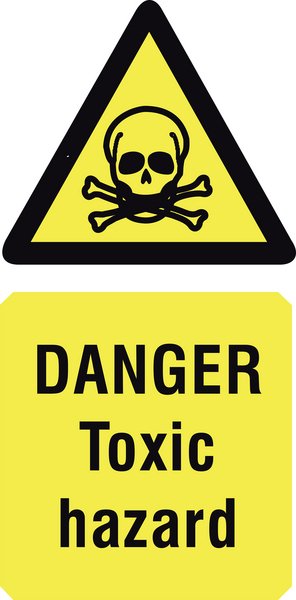
Just like canaries, our children are significantly more vulnerable than adults, as these chemicals affect their developing bodies in more ways that are still difficult to fathom.
So, our children are growing up as a part of a giant experiment with potentially devastating consequences.
How will these chemicals affect their development, their health, their ability to achieve their full potential? Will our children end up paying the price for our negligence for the rest of their lives?
And is there anything that we do about it?
Step 1: Ignorance Is NOT Bliss
Step one is to get educated about the problem.
Ignorance is NOT bliss when it comes to our health. Not knowing about a disturbing issue will NOT cause it to go away!
Did you know that of 60,000+ chemicals that were grandfathered by TSCA law only about 200 were ever tested for safety directly by the EPA?
The Toxic Substances Control Act (ToSCA) of 1976 mandated the EPA to protect the public from “unreasonable risk of injury to health or the environment” by regulating the manufacture and sale of chemicals. One might think that Environmental Protection Agency exists to protect the public from dangerous and potentially carcinogenic substances, but thousands of chemicals were never tested by the EPA because they were not considered an “unreasonable risk.”
So, contrary to what the name implies, TSCA does not separate chemicals into categories of toxic and non-toxic. Rather it prohibits the manufacture or importation of new chemicals that are not on the TSCA 60,000+ Inventory grandfathered when the law was passed!
As a parent I find it deeply disturbing, not to say scary.
Listen to the interview with a world-renowned pediatrician and environmental health expert Dr. Leo Trasande, who will explain how chemical exposures put our kids at risk, how much environmentally-mediated illness costs our nation, and what steps we can take to protect our children from harm.
Listen to the Green Street Radio or download the mp3 file here here.
Of course, there is huge money at stake for the manufacturers. The titans of the cosmetics industry are hard at work fighting common sense laws that would keep toxic chemicals out of everything from bubble bath, mattresses, clothing to lipstick.
But the costs to the society and the environment that we are all paying can no longer be ignored.
Step 2: Start Taking Action
Starting with the smallest action – “voting with your purse” and not buying the products that contain toxic ingredients. Many of the toxic cleaning products can be easily substituted with safer alternatives, for example, baking soda, vinegar, lemon juice are great for household cleaning needs.
But ultimately we can’t shop our way out of this problem.
Help spread the message – tell others about what you learned.
Write to the companies that are using toxic products to let them know your concerns.
Write to your elected officials demanding their support for the bills that promote positive change.
Join or support an organization working to increase public awareness and change the laws.
Our children are completely dependent on us to take action and make the right decisions for them!
More Resources:
Tell Congress to Stop Industry’s Trojan Horse Bill “The Cosmetic Safety Amendments Act of 2012” was recently introduced by Representative Leonard Lance (R-NJ). According to the Campaign for Safe Cosmetics organization “This is a classic Trojan horse – it may sound like a step forward on the surface but the “fine print” inside the bill would allow industry to continue placing profits over public health. This bill would put into law the current system that allows the industry to “self-regulate” the safety of cosmetics which has resulted in carcinogens in baby shampoo, lead in lipstick, formaldehyde in hair products, hormone disruptors in fragrance and mercury in face creams. It would also handcuff states from taking action to pass locally tailored policies to protect the health of their own state residents. ”
The Campaign for Safe Cosmetics – The Campaign for Safe Cosmetics is a coalition effort launched in 2004 to protect the health of consumers and workers by securing the corporate, regulatory and legislative reforms necessary to eliminate dangerous chemicals from cosmetics and personal care products.
EWG’s Skin Deep database: EWG’s Skin Deep database gives you practical solutions to protect yourself and your family from everyday exposures to chemicals.

Toxic Chemicals in the Enviroment : How do they affect our kids and what can we do about it?
Questions? Comments? Suggestions?
If you have a favorite recipe, why not submit it here in the comment section of this smoothie recipes blog for others to enjoy too!
I also welcome any comments, questions and suggestions. Thanks!
One of the questions I most often get is “Are green smoothies good for diabetics?”
The main concern is, of course, the high fruit content of the smoothie – and the resulting sweetness of the drink causing blood sugar problems.
This is an important topic, so I’m going to address it in a series of posts, providing you with the information that I have on this topic, as well as giving you some low-fruit or no-fruit recipes. But first, I want to talk about two important concepts for people with blood sugar problems, the glycemic index of foods versus glycemic load.
There is a widespread misconception that all foods that have a high glycemic index should be eliminated from the diet because of their ability to cause a rapid spike in blood glucose levels. Common theory supposes that a low glycemic index makes a food good for you, and a high glycemic index makes a food unhealthy. Many over-zealous anti-carbers have turned fruit and starchy vegetables into demon foods to be avoided at all costs.
This causes many people to avoid eating fruits & many of the sweeter/starchier vegetables.
This is a mistake.
The glycemic index (GI) ranks foods based on how fast they break down during digestion and thus how quickly their sugars enter the blood. So, in other words, the glycemic index tells you how fast carbohydrates turn into blood sugar. What the GI does not tell you is how much of that carbohydrate is in a serving of any food. Having both pieces of information is critical to correctly assess a food’s effect on blood sugar levels.
That is where the concept of “Glycemic Load” (GL) comes in.
Glycemic Index Versus Glycemic Load
While the Glycemic Index is most commonly known as an indicator to how healthy or unhealthy a food is, it is actually the Glycemic Load that you should pay attention to, not just the GI.
The Glycemic Index measures the speed at which a certain food raises blood sugar in relation to a control food. Glycemic Index uses a scale of 0 to 100, with higher values given to foods that cause the most rapid rise in blood sugar. Pure glucose serves as a reference point, and is given a Glycemic Index (GI) of 100. GI’s of 55 or below are considered low, and 70 or above are considered high. However, GI alone is NOT an accurate measure of how much of a certain food raises blood sugar.
The Glycemic Load, on the other hand, ranks foods based on portion size and grams of carbohydrates per portion. This gives a much more accurate view of how foods might affect blood sugar. To calculate the Glycemic Load of a food, take the number of grams of carbohydrates in a serving, multiply it by it’s Glycemic Index, then divide it by 100. GL’s of 10 or below are considered low, GL of 11 to 19 inclusive is medium, and 20 or above are considered high. Foods that have a low GL almost always have a low GI. Foods with an intermediate or high GL range from very low to very high GI.
The glycemic load is a relatively new way to assess the impact of carbohydrate consumption, giving a fuller picture than glycemic index alone. A GI value tells you only how rapidly a particular carbohydrate turns into sugar. It doesn’t tell you how much of that carbohydrate is in a serving of a particular food. You need to know both things to understand a food’s effect on blood sugar levels.
To give you an example, the carbohydrate in watermelon has a high glycemic index, but there isn’t a lot of it, so watermelon’s glycemic load is extremely low.
Glycemic Index and Glycemic Load of Fruits
| FRUITS |
Serving size (grams) |
Glycemic index (glucose = 100) |
Glycemic load per serving |
| Apple, average |
38±2
|
120
|
6
|
| Banana, ripe |
51
|
120
|
13
|
| Dates, dried |
103±21
|
60
|
42
|
| Grapefruit |
25
|
120
|
3
|
| Grapes, average |
46±3
|
120
|
8
|
| Orange, average |
42±3
|
120
|
5
|
| Peach, average |
42±14
|
120
|
5
|
| Peach, canned in light syrup |
52
|
120
|
9
|
| Pear, average |
38±2
|
120
|
4
|
| Pear, canned in pear juice |
44
|
120
|
5
|
| Prunes, pitted |
29±4
|
60
|
10
|
| Raisins |
64±11
|
60
|
28
|
| Watermelon |
72±13
|
120
|
4
|
Via http://www.health.harvard.edu/
This table demonstrates that all fruit has a low glycemic load, except dried dates and raisins. It is best to eat fruit fresh, as drying and dehydrating concentrate fruit sugars to an unnatural level that the body is not designed to handle well. It is also important to eat fruit whole, not juiced, as the fiber in fruit slows sugar absorption to its natural speed.
When you eat fruit whole and raw, it is hard to get excess sugar from fruit. Fruit isn’t in the same category of foods as table sugar, high fructose corn syrup, maple syrup or candy. Fruit contains vitamins, minerals and antioxidants that counter-balance the potential harmful effects of the sugars in fruit. The fiber in fruit slows down the release of sugars, reducing the speed at which fruit may raise your blood sugar.
Glycemic Load of Vegetables
All vegetables are super-low on the glycemic load scale. They are basically glycemic-free (and guilt-free) foods!
The numbers are the grams of available carbohydrate (that is, carbohydrate minus dietary fiber) in 100 grams of the portion of the food):
VEGETABLES:
Alfalfa seeds, sprouted 1.28
Arugula 2.05
Asparagus, cooked 2.63
Bamboo shoots, cooked 0.92
Beans, green, cooked 4.69
Beans, snap, green, cooked 4.68
Beet greens, cooked 2.56
Broccoli, cooked 2.16
Brussels sprouts, cooked 4.5
Cabbage, cooked 2.16
Cauliflower, cooked 1.41
Celeriac (celery root), cooked 4.7
Celery 1.95
Chard, swiss, cooked 2.04
Collards, cooked 2.1
Cucumber 1.8
Dandelion greens, cooked 3.5
Eggplant, cooked 4.14
Endive 0.25
Fennel, bulb 4.19
Green onions, young, tops only 3.94
Hearts of palm, canned 2.22
Jicama 3.92
Kale 3.63
Lettuce, butterhead 1.32
Lettuce, cos or romaine 0.67
Lettuce, iceberg 0.69
Mustard greens, cooked 0.1
Mushrooms 2.94-3.57 (except shitake)
Nopales, cooked 1.27
Okra, cooked 4.71
Olives, canned ripe 3.06
Parsley 3.03
Peppers, serano 3.00
Peppers, jalapeno 3.11
Peppers, sweet green 4.63
Peppers, sweet red 4.43
Purslane 3.43
Radicchio 3.58
Radishes 1.99
Rhubarb 2.74
Sauerkraut 1.78
Scallions (green onions) 4.74
Spinach, cooked 1.35
Squash, zucchini, cooked 2.53
Tomatillos 3.93
Tomatoes 3.54
Tomato juice 3.83
Turnips, cooked 2.9
Turnip greens, cooked 0.86
Watercress 0.79
Source: http://www.mendosa.com/freefoods.htm
Glycemic Load of Green Smoothies
The bottom line is that even if you include fruits in the smoothie, the overall Glycemic Load of the smoothie will still remain VERY LOW thanks to the low glycemic index of fruits and super-low (almost negligible) glycemic load of raw vegetables and greens.
For non-diabetic people, it is not needed to restrict consumption of fruit or green smoothies in order to prevent the disease, as there is no evidence that drinking green smoothies, or increasing fruit intake causes diabetes.
Limitations of the Glycemic Index and the Glycemic Load
Some proponents of the Glycemic Index (including many diet books authors) would like you to believe that GI and GL are all that matters when selecting which foods to eat. In reality, diet is a more complex issue than that.
Many other factors influence individual glycemic response, including preparation method, combination with other foods, as well as individual differences in glycemic response.
How the Glycemic Index can lead to overeating
Using the Glycemic Index and Glycemic Load can be misleading and lead to overeating.
Apples have a GI of 38, and a medium-size apple, contains about 18 grams of net carbohydrates and provides a Glycemic Load of 5. This is a low GL, and most would consider the apple to be a very appropriate snack. But now look at peanuts. A 4-oz serving not only weighs less than the apple, but has a much lower GI (14), and provides an even lower GL of 2. Based on Glycemic Load alone, you would have to believe that the peanuts were a better dietary choice than the apple. But if you take a look at the total Calories contained in these two foods, you’ll see that the apple contains approximately 77 Calories, while the peanuts contain more than 500! Those 400+ extra Calories are NOT going to help you lose weight.
The Conclusion?
Eat your fruits and vegetables! All of them! Any kind you like! And do it without guilt.
Instead of worrying about glycemic index of foods, make sure you consume lots of unprocessed, preferably raw plant foods: leafy greens, celery, cucumbers, tomatoes, peppers, etc., as well as raw fruits.
It would really be a major challenge to overeat vegetables and fruits. The average woman who needs at least 1500 calories per day would likely find it very difficult to eat 15 large potatoes or bananas. In general, vegetables and fruits fill you up long before you can eat enough to fill you out.
If you’re really worried about blood sugar levels or trying to lose weight, you may want to lay off the bananas, starchier tubers and root vegetables to speed up the process. But from a strict maintenance or health point of view, you should embrace all the vegetables and fruits you feel like eating.
The American Diabetes Association (ADA) says, “Therefore, the use of added fructose as a sweetening agent is not recommended; however, there is no reason to recommend that people with diabetes avoid naturally occurring fructose in fruits, vegetables, and other foods.”
Questions? Comments? Suggestions?
If you have a favorite recipe, why not submit it here in the comment section of this smoothie recipes blog for others to enjoy too!
I also welcome any comments, questions and suggestions. Thanks!
Did you know the green you see in nature – called chlorophyll – is the most powerful healer on earth?
For millions of years before we humans discovered fire, we had been eating lots of green leaves. It’s the perfect food for humans, rich in vital nutrients necessary for health and disease prevention. Research shows the more leafy greens you eat, the longer you live!
Unfortunately, today, most people eat very little greens, if at all.
Let’s face it, for most people, leafy greens are not the most desirable or palatable foods that exist.
That’s one more reason to make drinking green smoothies a habit. Green smoothies are one of the easiest, most efficient ways to get those greens in every day in the raw state – plus, they’re DELICIOUS!
By drinking 2 or 3 cups of green smoothies daily you will consume enough greens for the day to nourish your body, and all of the beneficial nutrients will be well assimilated.
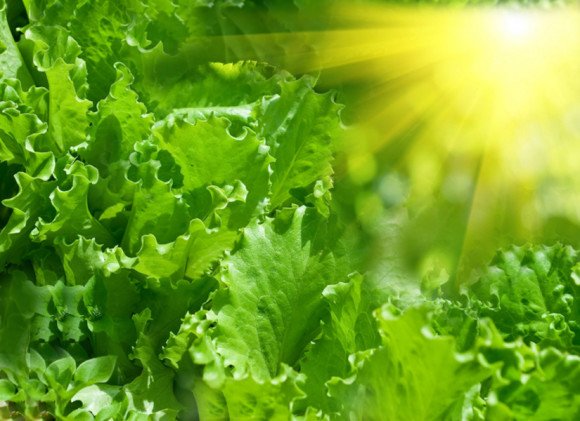
Chlorophyll: The Miracle of Nature
What is Chlorophyll?
Chlorophyll (also chlorophyl) is a green pigment found in almost all plants, algae, and cyanobacteria. Its name is derived from the Greek words χλωρος, chloros (“green”) and φύλλον, phyllon (“leaf”). Chlorophyll is an extremely important biomolecule, critical in photosynthesis, which allows plants to absorb energy from light.
Chlorophyll is actually very similar to human blood, to the hema in human hemoglobin. It helps us rebuild our blood, and it goes without saying that healthy blood is critical to being healthy. Hemoglobin is the component of the blood that carries oxygen. It contains a single molecule of iron, as does chlorophyll. That’s one of the reasons why chlorophyll is so beneficial to the body. It can help to oxygenate the blood in a similar way to hemoglobin.
Research shows the more leafy greens you eat, the longer you live!
10+ Benefits of Chlorophyll
Most people know about the benefits of vitamins and minerals, and the benefits of antioxidants, but to many the benefits of chlorophyll remain unknown.
Chlorophyll has numerous health benefits. Here are some of the known chlorophyll benefits that I found just by doing a quick research online. If you want scientific studies to support those claims, you will have to do the research yourself, sorry.
- Chlorophyll cleanses and oxygenates the blood. It helps the blood carry oxygen to all cells and tissues.
- Having more oxygen available in the blood translates to better endurance and an overall reduction in fatigue.
- Chlorophyll is important in offsetting stress and alkalizing the body.
- Chlorophyll blocks absorption of toxic carcinogens. It helps neutralize free radicals that do damage to healthy cells. it is helpful in protecting the body against toxins and in reducing drug side effects
- Chlorophyll has been seen to help in the growth and repair of tissues.
- Chlorophyll is a natural deodorant. I reduces bad breath, urine, fecal, and body odor.
- Chlorophyll helps to treat infected wounds naturally.
- Chlorophyll has anti-carcinogenic properties.
- Chlorophyll cleanses the liver and digestive tract, boosts blood with iron, vitamin C and folic acid.
- Chlorophyll supports the respiratory system and our moods.
- Chlorophyll is sometimes recommended for anemia, atherosclerosis, wound healing, bad breath, body odor, detoxification, diabetes, high cholesterol, rheumatoid arthritis and herpes infections.
Despite all these benefits, chlorophyll is not considered an essential nutrient, so there are no official daily recommendations for its use, and you will not find it on nutritional fact labels.
Best Natural Sources of Chlorophyll
It’s usually easy to tell when a food has significant amounts of chlorophyll, because chlorophyll provides the green color that is found in grasses, leaves, and many of the vegetables that we eat.
Leafy greens are the main food sources that are rich in chlorophyll content. The amount of chlorophyll found in each plant varies. In spinach, for example, chlorophyll is present by as high as 1% based on dry weight estimation.
Chlorophyll-rich leafy greens include:
Green vegetables that contain lots of chlorophyll include asparagus, bell peppers, broccoli, Brussels sprouts, green cabbage, celery, green beans, green peas, leeks, and green olives.
Sea vegetables and blue-green algae, chlorella, and spirulina are also super-concentrated sources of chlorophyll. Chlorella is a single celled algae that is by far the richest source of chlorophyll in the world. It has 10 times more chlorophyll than alfalfa, which is where most commercial chlorophyll comes from.
Raw Versus Cooked Greens
Cooking destroys much of the chlorophyll, which is why consumption of these green leaves and vegetables RAW is the best way to obtain the health benefits of chlorophyll.
Although cooking makes food softer and easier to digest for people with digestive problems, however, in the process of heating, most essential vitamins and enzymes in the food get destroyed. In this respect, blending is a lot less harmful than cooking because it saves all the vital nutrients in the food.
When cooking leafy greens and green vegetables, very short steaming is best. Short steaming may actually help absorb more chlorophyll from the plant, especially for people with weakened digestion. However, overcooking should definitely be avoided!
Practical Tips
1. Blend well for optimum absorption. Even though raw green vegetables are full of chlorophyll, many people, especially those who are really sick – do not absorb this chlorophyll due to the poor shape their colon is in. Blending on high speeds with a power-blender such as Vitamix or Blendtec, is a must. During blending, the cells of the greens and the fruits are ruptured, making the valuable nutrients easy for the body to assimilate. Digestion starts in the mouth and these tiny particles then become so easy for the body to digest that they are bio-available as soon as you start drinking them.
Juicing is also a good option as juicing green foods eliminates the fiber, making the juice and the chlorophyll easy to be absorbed by your body in a few minutes. Steaming is another option for people with weakened digestive systems.
2. Pace yourself to avoid unpleasant detox side effects. Chlorophyll, because it is such a powerful detoxifying agent, can affect a body very strongly. A person who has a lot of stored toxins in their system can experience side effects from the detoxification process. When toxins are released into the bloodstream for processing, it can have many unpleasant detox symptoms, so if your diet has been extremely chlorophyll-deficient, you may want to start slowly.
3. Rotate your greens. Also, please remember that it is very important to rotate the greens you consume, so that you are not eating the same greens all the time.
4. Use organic produce, or – better yet – grow your own.
Liquid Chlorophyll Products Vs Green Smoothies
OK, so maybe I’m biased, but in my humble opinion eating or drinking your chlorophyll in salads and green smoothies is far superior to any liquid chlorophyll extract. Extracting a single compound, such as chlorophyll, from plants and drinking it, rather than consuming the whole leaves, whether that’s lettuce, cabbage, spinach or carrot tops, will remove beneficial co-nutrients and so could have less benefit than eating whole fresh leafy greens.
Green smoothies are one of the easiest, most efficient ways to get those greens in every day in the raw state – plus, they’re DELICIOUS!
Can You Take Too Much Chlorophyll?
There are differences of opinions about this question. The good news is that if you are eating whole foods, it’s practically impossible to overdose on chlorophyll!
Take a Chlorophyll Challenge
Every day, pick two foods rich in chlorophyll and have a big serving – in a green smoothie, raw green juice, raw salad, raw soup, or other; and take note what is happening in your body.

Take a Chlorophyll Challenge: Every day, pick two foods rich in chlorophyll and have a big serving – in a green smoothie, salad, raw soup, or other.
Questions? Comments? Suggestions?
If you have a favorite recipe, why not submit it here in the comment section of this smoothie recipes blog for others to enjoy too!
I also welcome any comments, questions and suggestions. Thanks!
In the first part of Why Buy Organic? I talked about the pesticides, herbicides, and other toxic substances that are used to grow conventional produce.
However, toxins in conventional produce is only part of the story. The other important piece, is the amount of nutrients in conventional vs organic produce.
Many people purchase organic food because they believe it is healthier than conventionally grown food. Yet, the organic industry is constantly told that there is no evidence to support these claims. I’ve read on more than one occasion about “research” that “proved” the equal nutritional value of conventional produce when compared with organic.
I don’t believe that at all.
While certainly eating conventional produce is better than not eating plant foods at all, organically produced fruits and vegetables contain much higher amounts of nutrients, and therefore are more nutrition-rich and health promoting, than their conventional counterparts.
And there are numerous studies that prove that.
“Research published in 2001 showed that the current fruit and vegetables in the USA have about half the vitamin content of their counterparts in 1963. This study was based on comparing published US Department of Agriculture (USDA) figures.
A scientific study published in the Journal of Applied Nutrition in 1993 clearly showed that organic food is more nutritious than conventional food.
Organically and conventionally grown apples, potatoes, pears, wheat, and sweet corn were purchased in the western suburbs of Chicago, over two years, and analyzed for mineral content. The organically grown food averaged 63% higher in calcium, 73% higher in iron, 118% higher in magnesium, 178% higher in molybdenum, 91% higher in phosphorus, 125% higher in potassium and 60% higher in zinc. The organic food averaged 29% lower in mercury than the conventionally raised food.
A peer reviewed scientific article published in the February 2003 edition of the Journal of Agricultural and Food Chemistry stated that organically grown corn, strawberries and marionberries have significantly higher levels of cancer fighting antioxidants than conventionally grown foods. Some of these compounds, such as Flavonoids, are phenolic compounds that have potent antioxidant activities. Many are produced in plants in response to environmental stresses, such as insects or competing plants. They are protective compounds that act as a plant’s natural defense and also have protective properties in human and animal health.
The research suggested that pesticides and herbicides disrupt the production of these protective compounds. Good soil nutrition appears to increase the levels of these natural compounds that have anti cancer, immune boosting and anti aging properties.” via http://www.permaculture.com/drupal/node/144
It’s All In the Soil
The main reason for this is the quality of the soil.
If we care about the nutrition that we receive from our food, we absolutely must not ignore the quality of nutrients plants receive from the soil because the quality of the soil in which the plants grow has a huge influence on our health and on the health of the animals that eat those plants.
The soil plants grow in are as important to our health as plants themselves, if not more!
Conventional agriculture ignores the complex ecosystems of the soil and focuses their efforts at supplying potassium, nitrogen and other chemicals to the plants.
Organic farmers, on the other hand, make sure they are feeding the living microorganisms in the soil, which are essential for growing plants that are rich in nutrients and health promoting minerals.

Organic vs conventional produce: Nutrients come from the the soil
Microorganisms in the soil cannot survive when fed artificial fertilizers, and when all microorganisms die because of the overuse of chemicals, the soil turns into dust.
Here is an interesting fact: “the combined weight of all the microbial cells on earth is twenty-five times that of its animal life; every acre of well-cultivated land contains up to a half a ton of thriving microorganisms, and a ton of earthworms which can daily excrete a ton of humic casting.” (Peter Tompins and Christopher Bird “Secrets of the Soil.)
Most of the soil of agricultural farms in the USA contains less than 2% of organic matter, while originally, before the era of chemistry, it was 60-100%.
According to David Blume, an ecological biologist and permaculture expert, “Most Class I agricultural soil is lucky to hit 2% organic matter – the dividing line between a living and dead soil”. By applying permaculture gardening techniques to a field of extremely depleted soil, which consisted of cement-hard adobe clay, David Blume was able to bring the organic matter to the 25% level within just a couple of years. From this field he harvested the crops “8 times what the USDA claims are possible per square foot” via “Green For Life” by Victoria Boutenko
Organic Vs Conventional Nutrition

Organic vs conventional produce nutrition
Solutions are available, and decisions are being made now. I will write about the in the next installment of “Why buy organic?”.
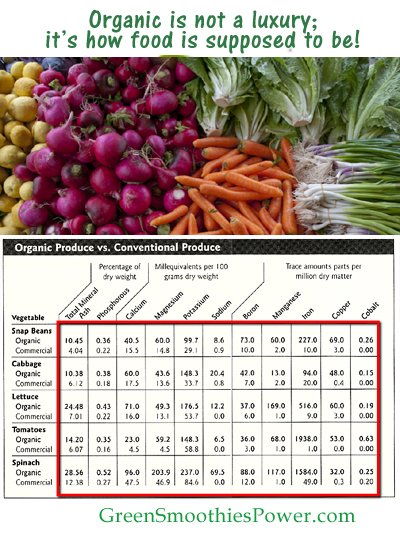
Organic vs conventional produce nutrition; via Green For Life by Victoria Boutenko
Questions? Comments? Suggestions?
If you have a favorite recipe, why not submit it here in the comment section of this smoothie recipes blog for others to enjoy too!
I also welcome any comments, questions and suggestions. Thanks!
If you haven’t been on a highly plant-based diet for a while, chances are you may experience some unpleasant cleansing reactions (detox) when you start drinking your green smoothies.
I’ve had many readers report to me that the experience various symptoms that range from mildly unpleasant to quite unbearable.
“I spent the afternoon and evening (really until I went to bed) in misery!! Achy muscles, head ache, stomach ache, gassy and nautious. Yesterday was the third day in a row I needed a small afternoon nap. I was starting to think I was pregnant again!!”
“I have been experiencing diarreha ever since I started drinking green smoothies. Is there something that I can do to help this go away? I want to continue with the smoothies, but I am getting afraid that something is wrong.”
When I started drinking green smoothies a couple of years ago I remember having flu-like symptoms, with a mucus in the back of my throat for about five weeks.
Fortunately, in most cases these reactions are short lived. They are simply a manifestation of your body using good building and cleansing materials that you are providing, and an opportunity to discard the toxic waste materials.
Why Do I Need to Detox?
Do I need to even answer that question?
Our bodies naturally detoxify every day. Detoxification is a normal body process of eliminating or neutralizing toxins through the colon, liver. However, although the human body is very skilled at filtering out environmental and dietary toxins through the liver, kidneys, lungs, and skin, just like any other filter, prolonged use without proper cleaning can reduce efficiency and cause toxic build up.
Food preservatives, pesticides and herbicides, genetically engineered foods, estrogen-mimicking chemicals leaking from plastic bottles and containers, hormones, antibiotics and drugs infused into the meat, poultry and fish, mercury in fish, chemicals in skin care products, chemicals in water that we drink – there is just so much that your body needs to handle every day.
No wonder our bodies are breaking down and we are feeling sluggish or out of sync! Symptoms of internal toxic build up include lack of energy, chronic fatigue, acne and other skin breakouts, constipation, allergies, dark urine, weight gain, respiratory problems, and many other.
Anybody can benefit from a cleansing. It’s a way to recharge, rejuvenate, and renew. Especially in the spring, when the body is coming out of what might be called hibernation. It’s a way you can jump-start your body for a more active life, a healthier life.
Natural Detox Cleanse Reactions On Green Smoothie Diet:
Here are some natural detox cleanse reactions that you may experience when you start adding green smoothies to your diet:
* headaches
* digestive disturbances
* skin breakouts or rashes
* feeling of sluggishness or weakness
* intestinal gas
* mucus in the back of the throat
* mood swings
* and other
The good news is that those reactions rarely last longer than a couple of days or weeks.
By drinking green smoothies you will be replacing lots of other foods – many of them unhealthy – in your daily diet. So, not only does a green smoothie detox give your digestive system a break, but by eliminating added sugar and other additives in the processed foods, saturated fats, and alcohol, it also rids your diet of things that can exacerbate health issues.
The longer you’ve been eating the S.A.D. (Standard American Diet), and the worse your diet, and the weaker your inherited constitution, the more likely you are to have tough time detoxing. If a “cleansing reaction” lasts longer than 2 weeks, it’s possible that you may be looking at a food sensitivity.
If they are really unpleasant, maybe you may want to reduce the amount of the smoothie that you drink temporarily.
And follow the tips for healthy detox below.
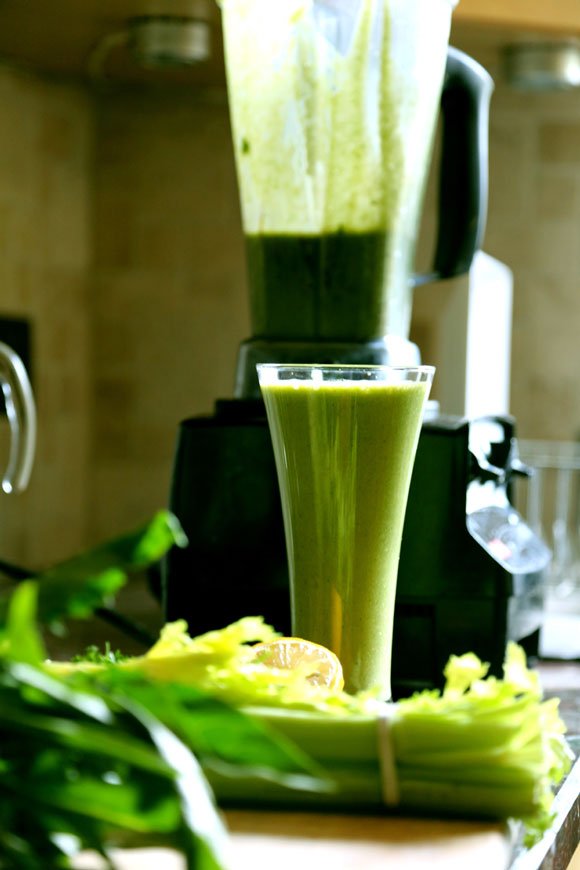
Detox cleanse: You may have to endure some unpleasant symptoms, but just think about the benefits of cleansing your body!
10+ Tips for Healthy Detox
1. Drink green smoothies and green juices.
Make sure you use organic greens and fruits (especially the ones on the Dirty Dozen list – in the United States alone, more than one billion pounds of pesticides are deliberately released into the environment every single year. Among these are some of the most dangerous synthetic chemicals manufactured today.).
2. Rotate your greens (don’t use the same greens all the time). Add some fresh ginger and lemon juice to your smoothies.
3. Eliminate caffeine, processed foods, simple sugars, smoking, and alcohol.
4. Consume lots of raw fruits and vegetables.
5. Drink extra water to help flush out toxins faster. Also, drink infusions using lemon, ginger, senna, milk thistle, star anise, fennel, and other herbs made with warm or hot water.
6. Eliminate all animal products: meat, fish and dairy, even if just for a few days and see how you feel
7. Eliminate or minimize use of chemical-based household cleaners and personal care products (cleansers, shampoos, deodorants and toothpastes), and substitute natural alternatives.
8. Rest and limit stressful life situations along with detoxifying your body. Yoga and meditation are two simple and effective ways to relieve stress.
9. Sweat in a sauna so your body can eliminate wastes through perspiration.
10. Dry-brush your skin to remove toxins through your pores. Special brushes are available at natural products stores.
11. Exercise. Jumping on a mini-trampoline or jump-roping will invigorate you and help cleanse your lymphatic system.
12. Massage your intestines. Before you get out of bed in the morning, deeply massage your transverse colon (you may use a tennis ball or your hands), starting lower right in your pelvis, straight up to the level of your navel, across to a couple inches inside the left hipbone, and down.
But, please, don’t abandon your new routine. Keep in mind that your body is doing good, necessary work, you ARE burning fat, eliminating toxins, and the discomfort is temporary.
If you are trying to lose weight, this you will start seeing results soon. When you replace high-calorie foods with low-calorie, high-nutrition foods (green smoothies!), weight loss will follow. You will start feeling lighter and more energetic soon!
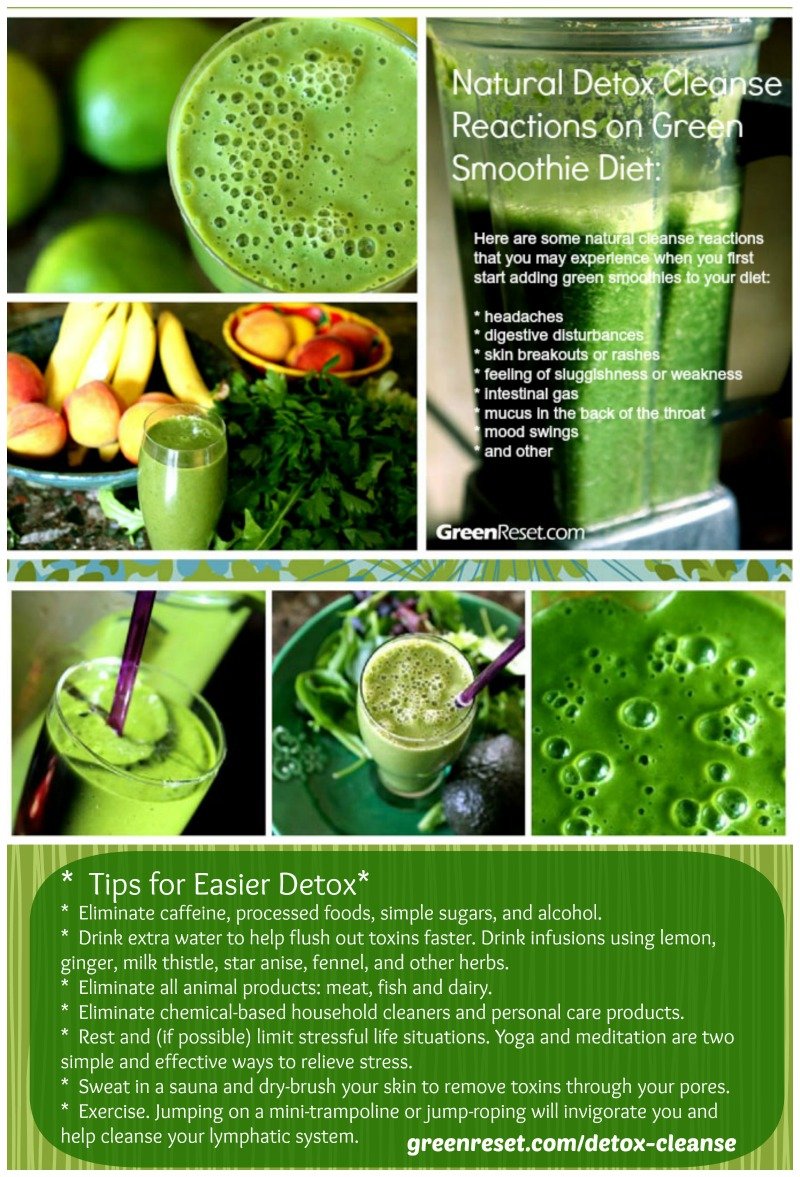
Questions? Comments? Suggestions?
If you have a favorite recipe, why not submit it here in the comment section of this smoothie recipes blog for others to enjoy too!
I also welcome any comments, questions and suggestions. Thanks!
I admit I have been kind of lazy in the past, rarely buying organic produce (I have to drive 5+ miles to the nearest Wholefoods to get organic greens), but shopping mostly at a local grocery store that sells conventionally grown instead.
So one day, I finally decided to really look into this issue a little deeper, starting with checking the pesticide content of the greens that I use for my smoothies.
The fruits and greens that I use in my green smoothies are fabulous foods, full of vital nutrients that are supposed help keep our bodies strong and immune to disease, right?
Well, sort of.
Many studies show that most conventionally farmed foods have pesticide and other chemical residues. Repeated tests show that many of these foods can literally carry “a cocktail of synthetic poisons.” A growing body of science is showing that repeated exposures, to cocktails of small amounts of synthetic chemicals, have a range of adverse health effects.
Of course, I knew that, but I decided to investigate exactly which foods are most contaminated, and make a list of foods that I need to buy organic at your farmer’s market or supermarket that carries organic produce.
Here is what I found out.
The average conventionally grown apple has 20 to 30 artificial chemicals on its skin, even after rinsing. If you’re eating non-organic celery today, you may be ingesting 67 pesticides with it, according to a report from the Environmental Working Group (EWG).
Many scientists believe these exposures, of minute quantities of agricultural chemicals, are very significant, especially for children.
The Environmental Working Group, a nonprofit focused on public health, scoured nearly 100,000 produce pesticide reports from the U.S. Department of Agriculture and the U.S. Food and Drug Administration to determine what fruits and vegetables we eat have the highest, and lowest, amounts of chemical residue.
Most alarming are the fruits and vegetables dubbed the “Dirty Dozen,” which contain 47 to 67 pesticides per serving. These foods are believed to be most susceptible because they have soft skin that tends to absorb more pesticides.
The Dirty Dozen – Buy Organic if possible
So here is the list of the so-called Dirty Dozen, the foods that are most contaminated, so we need to limit their consumption or only buy organic:
Celery
Peaches
Strawberries
Apples
Blueberries
Nectarines
Sweet bell peppers
Spinach, kale and collard greens
Cherries
Potatoes
Grapes (imported)
Lettuce
Other than bananas (that are not on this list) and potatoes (that are on this list buy we don’t eat them as often), this list contains most fruits and vegetables that I frequently use in my green smoothies and salads!
The Clean 15
Conventional Produce Lowest in Pesticides
Not all non-organic fruits and vegetables have a high pesticide level. Some produce has a strong outer layer that provides a defense against pesticide contamination. The group found a number of non-organic fruits and vegetables dubbed the “Clean 15” that contained little to no pesticides.
Onions
Avocados
Sweet corn
Pineapples
Mango
Sweet peas
Asparagus
Kiwi fruit
Cabbage
Eggplant
Cantaloupe
Watermelon
Grapefruit
Sweet potatoes
Sweet onions
Honeydew Melon
To limit your exposure, it makes sense to peel fruits, if possible, and not to eat skins, unless you are able to purchase those vegetables in organic form. Remove and discard the outermost leaves of lettuce and cabbage, and other surfaces that cannot be peeled can be washed with soap and water, or a commercial vegetable wash.
Some of my favorite foods and ingredients for my smoothies are on the dirty-dozen list. And even the “OK to eat produce” isn’t completely safe. At my house, we do consume lots of green smoothies, so, needless to say, I worry about the toxins level, especially when it comes to my son.
For example, a study out of Harvard shows that even tiny, allowable amounts of a common pesticide class can have dramatic effects on brain chemistry. Organophosphate insecticides (OP’s) are among the most widely used pesticides in the U.S. & have long been known to be particularly toxic for children. This is the first study to examine their effects across a representative population with average levels of exposure. Finding :: Kids with above-average pesticide exposures are 2x as likely to have ADHD. Read the full report
The chemicals sprayed on conventional food crops have been linked to numerous diseases, including birth defects, Parkinson’s, numerous cancers and diabetes.
Here is where you can check the pesticide residue on popular produce – go to http://www.whatsonmyfood.org/
I don’t know about you, but I find it appalling that eating these (and other) foods that we buy because they are healthy (and delicious) can make us sick!
Personally, I don’t want to worry about the dangerous toxins when I buy my fruits, vegetables and greens for juicing, blending or cooking.
Organic is not a luxury; it’s how food is supposed to be!
Buying organic and pesticide-free whenever possible makes sense and is an important start. But being a responsible consumer will not make enough of a difference to make our food system sustainable and safe for ourselves and future generations.
In the second installment of this article I’ll be writing about nutritional value of organic versus conventional produce.
Solutions are available, and decisions are being made now. I’ll also be writing about what we can all do to make organic foods more available and affordable.
Questions? Comments? Suggestions?
If you have a favorite recipe, why not submit it here in the comment section of this smoothie recipes blog for others to enjoy too!
I also welcome any comments, questions and suggestions. Thanks!









